You’ve got a favourite corner restaurant in Buenos Aires, haven’t you? Whichever neighbourhood you live in or have stayed in, there’s surely one establishment, a restorán de la esquina, that’s captured your heart. Thanks to their very architecture, corner establishments in Buenos Aires stand out for that bevelled, three-sided entrance (known as arquitectura en ochava in Spanish) that lets diners and drinkers inadvertently interact, gazing out at a city in movement. And many of these classic establishments date back to the 19th century, oozing history, stories – oh, the tales these floors and walls could tell! Here, The Real Argentina visits four emblematic restaurant esquinas in Buenos Aires.
EL IMPERIO DE LA PIZZA, Chacarita
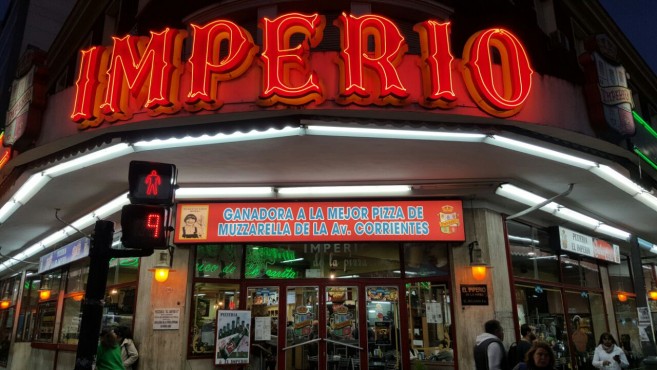
Not only is El imperio de la pizza perfectly placed on the cross streets of Avenues Corrientes and Federico Lacroze, one of Chacarita’s busiest esquinas, but this emblematic pizzería cleverly set up shop slap bang in front of a prime transport hub as well as Argentina’s largest cemetery; the living still have to eat, after all. Night manager Jorge Soto explains El Imperio’s success since opening its three sets of doors in 1947.
“This corner sees a lot of people from diverse backgrounds pass through: street vendors, office workers, labourers. They all stop by as we’re right in front of Federico Lacroze train and subway stations and from the moment El imperio opens in the morning, we’re full. All day, all night, people come and go.
“Monday to Friday we open at 5am and close at 2am, while we never close at weekends. At 5am, people come for pastries and coffee then go to work, maybe to a building site or take the train or subte. Others start coming in for a slice of muzza and fainá at 11.30am, then, when the home crowd returns from work, they drop by religiously for a slice at 7pm or 8pm.”
Although public transport in Buenos Aires has improved in the past couple of years, a porción of muzza or fugazetta is the perfect pick-me-up after a tough journey. Jorge adds: “Commuters come out of the subway, desperate for a slice of pizza, and they eat it standing.”
In addition, one man’s loss is another’s gain, given that the floor-to-ceiling windows of this emblematic esquina also overlook Argentina’s largest burial ground. He says: “El imperio is also located opposite Chacarita cemetery so people used to come to hold a wake for their dearly departed.”
What to order: a slice of muzza, obvio
Address: Corrientes 6895, Chacarita
Another notable corner worth a look in the barrio: Pizzería Santa María, Corrientes 6801
LA CABRERA, Palermo Soho
It will be 15 years in December since chef-patron Gastón Riveira turned a former mattress factory on the esquina of Thames and Cabrera into one of Buenos Aires’ most renowned steak houses. Born and bred in Palermo, Gastón always knew he’d open his first restaurant in his barrio – and that it would have a corner location.
He says: “This zone used to be filled with all kinds of workshops and the building La Cabrera occupies started out as a mattress factory; it later became a bar where people played cards, consuming the famous vermouth and soda from a syphon.”
“I was the chef at Buenos Aires News [nightclub] when I started to think about my first restaurant. Corners are a selling point with added value because of the double street view. I wanted it to look like a French bistro that was fun but broke all the fixed ideas that a restaurant usually offers. And this really is an esquina del barrio.”
“As I’m from Palermo, I have a lot of faith and affection for the barrio. I went to primary school on Güemes and Uriarte plus my grandfather had a furniture shop here; lots of pieces from his store are in the restaurant today.”
What to order: bife de chorizo to share, with fries
Address: Cabrera 5099, Palermo Soho
Another notable corner worth a look in the barrio: Don Julio, Guatemala 4699
DAMBLÉE, Almagro
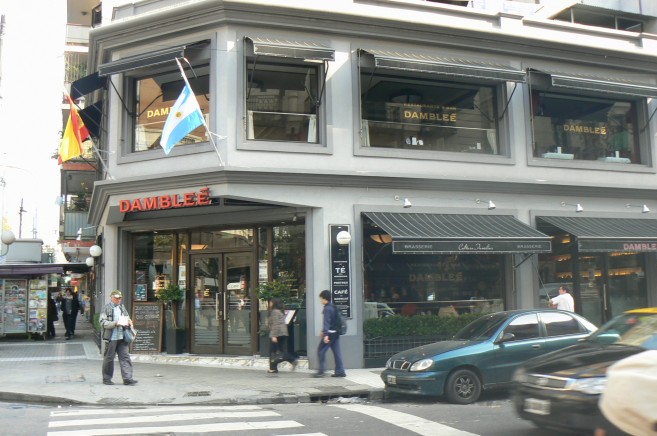
Sit at a table on the ground floor of Damblée, and sooner or later you’ll feel the throb of Buenos Aires, the A line rumbling underneath your thighs coupled with a steady stream of traffic heading north out of the city. In fact, this fish restaurant started out life on the opposite corner of Avenida Rivadavia 19 years ago before moving to the east side of this Almagro esquina in 2012.
Owner Gustavo Cano Vila says: “This corner dates back from 1935 to the 1960s when it was a casa de bailes carnival, then from 1965 onwards it was home to tango salon, Bailemos, on the first floor. A chocolate shop and bookstore have also functioned on the ground floor.”
“While we spent 18 months restructuring the interior, opening in 2011, we didn’t touch the outside so this corner still has those original typical high windows, with large openings.”
“This Almagro esquina is a typical Buenos Aires one; Carlos Gardel was born in this barrio. Our corner is precisely named after two Sánchez: Sánchez de Bustamante and Sánchez de Loria, two leaders who played crucial roles in the fight for Argentina’s independence. Avenida Rivadavia is pretty mystical too, as it’s considered one of the longest avenues in the world.”
Besides its emblematic esquina location, Damblée is one of Buenos Aires’ top seafood restaurants. Dine here and order chunky anchovies and grilled sardines – a rarity in BA – best paired with Argento’s Esquinas Pinot Grigio.
What to order: Grilled sardines with an apple salad
Address: Av. Rivadavia 3401, Almagro
Another notable corner worth a look in the barrio: Confiterías Las Violetas, Rivadavia 3899
LO DE JESÚS, Palermo Soho
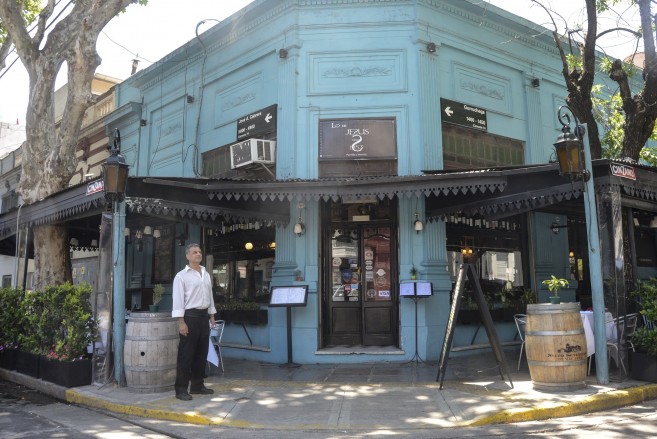
A bright turquoise esquina on Gurruchaga and Cabrera, this Palermo corner has always had a foodie, drinkie theme to it. Starting out as a small bar run by El Turco in the 1920s, Jesús Pernas took over the space in 1953.
It was Don Jesús’ cured ham sandwiches, cut with a Berkel slicer, and wife Lola’s matambres that really put this place on the map. Locals used to come to this general store to play cards, have a snack and sip vermouth or red-hued plonk back in the 1950s. These days, however, it’s home to one of Buenos Aires’ most pictueresque bodegones, Lo de Jesús. Original details such as paving stones shipped over from Europe remain, as does much of Don Jesús’ décor.
Martín Tomás Sammartino, owner, says: “This corner is bien de barrio, and Jesús used to live on one of the opposite esquinas. When we opened in 2002, the intention was to continue Don Jesus’ project from 1953 but making it more sophisticated, maintaining its essence and mysticism, but also serving steaks.”
“The interior dates back to the era: soda syphons, the mirrors, chandeliers, hams hanging from the ceiling, stained glass installed in 1906 plus we still have the Berkel slicer Jesús used to use. But the contemporary touch is that we open every day of the year at midday and close at 1am; the kitchen never shuts so if you desire a bife de chorizo at midday or 5pm, you can have it.”
As for Don Jesús himself, he’s still alive at 95 though he resides in a retirement home these days.
What to order: jamón crudo followed up by rib-eye or grilled pacú fish
Address: Gurruchaga 1406, Palermo Soho
Another notable bodegón corner worth a look in the barrio: Club Eros, Uriarte 1609


Latest posts by Sorrel Moseley-Williams (see all)
- AND THE BEST SOMMELIER IN ARGENTINA IS… - December 12, 2017
- CUATRO ESQUINAS: FOUR CLASSIC CORNER RESTAURANTS IN BUENOS AIRES - March 28, 2017
- Romance in Argentina: Dating Tips and Advice - February 10, 2017


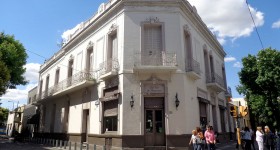 CUATRO ESQUINAS: FOUR NOTABLE CORNER BARS IN BUENOS AIRES
CUATRO ESQUINAS: FOUR NOTABLE CORNER BARS IN BUENOS AIRES 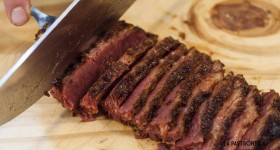 WHERE TO GO GLUTEN FREE IN BUENOS AIRES
WHERE TO GO GLUTEN FREE IN BUENOS AIRES  TOKYO IN BUENOS AIRES
TOKYO IN BUENOS AIRES 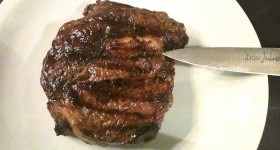 Meat & Greet the Best Steak Restaurants in Buenos Aires
Meat & Greet the Best Steak Restaurants in Buenos Aires 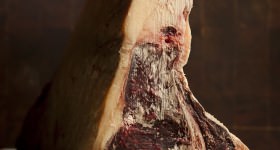 WHAT’S THE BEEF? OUR INSIDER’S GUIDE ON THE BEST CUTS TO ORDER AND WHERE IN BUENOS AIRES
WHAT’S THE BEEF? OUR INSIDER’S GUIDE ON THE BEST CUTS TO ORDER AND WHERE IN BUENOS AIRES  THE ESSENTIAL GUIDE TO EATING AND DRINKING IN ALMAGRO
THE ESSENTIAL GUIDE TO EATING AND DRINKING IN ALMAGRO 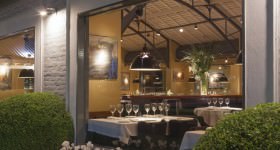 Clo Clo restaurant. A classy timeless tradition in Buenos Aires
Clo Clo restaurant. A classy timeless tradition in Buenos Aires 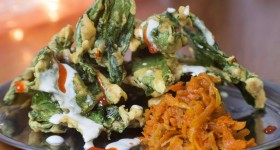 CHEF’S RECIPE: MARIANO RAMON, GRAN DABBANG IN BUENOS AIRES
CHEF’S RECIPE: MARIANO RAMON, GRAN DABBANG IN BUENOS AIRES 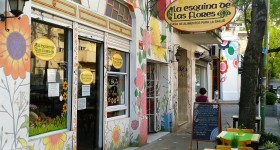 12 FRESH ORGANIC OPTIONS IN BUENOS AIRES
12 FRESH ORGANIC OPTIONS IN BUENOS AIRES 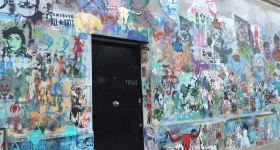 COSTA RICA: THE FOODIEST STREET IN BUENOS AIRES
COSTA RICA: THE FOODIEST STREET IN BUENOS AIRES 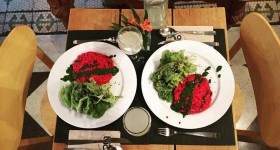 WHERE TO EAT VEGAN FOOD IN BUENOS AIRES
WHERE TO EAT VEGAN FOOD IN BUENOS AIRES